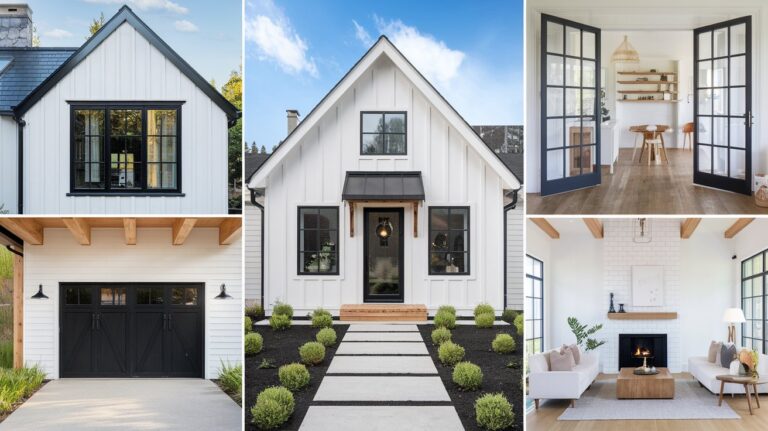White houses with black trim create a bold, classic look that catches everyone’s eye. When you add wood accents, you bring natural warmth that softens the stark contrast. This mix works because it balances strong visual lines with organic textures.
In this article, I’ll show you 17 ways to use this three-part color scheme for your home. You’ll find ideas for front porches, entryways, window treatments, door designs, and roof combinations.
Many homeowners struggle to make their house stand out without looking odd. This color trio solves that problem. It’s modern yet timeless.
I’ve gathered these ideas from top designers and real homes that have used this style successfully for years. You’ll see how to create a look that’s both dramatic and welcoming at the same time.
I’ll suggest 17 striking design ideas for white houses with black trim and wood accents. Let me search for some inspiration first.
Based on my research and the outline you provided, here are 17 striking design ideas for white houses with black trim and wood accents:
17 Ideas for White Houses with Black Trim and Wood Accents
Modern Minimalist with Natural Wood Door Trim
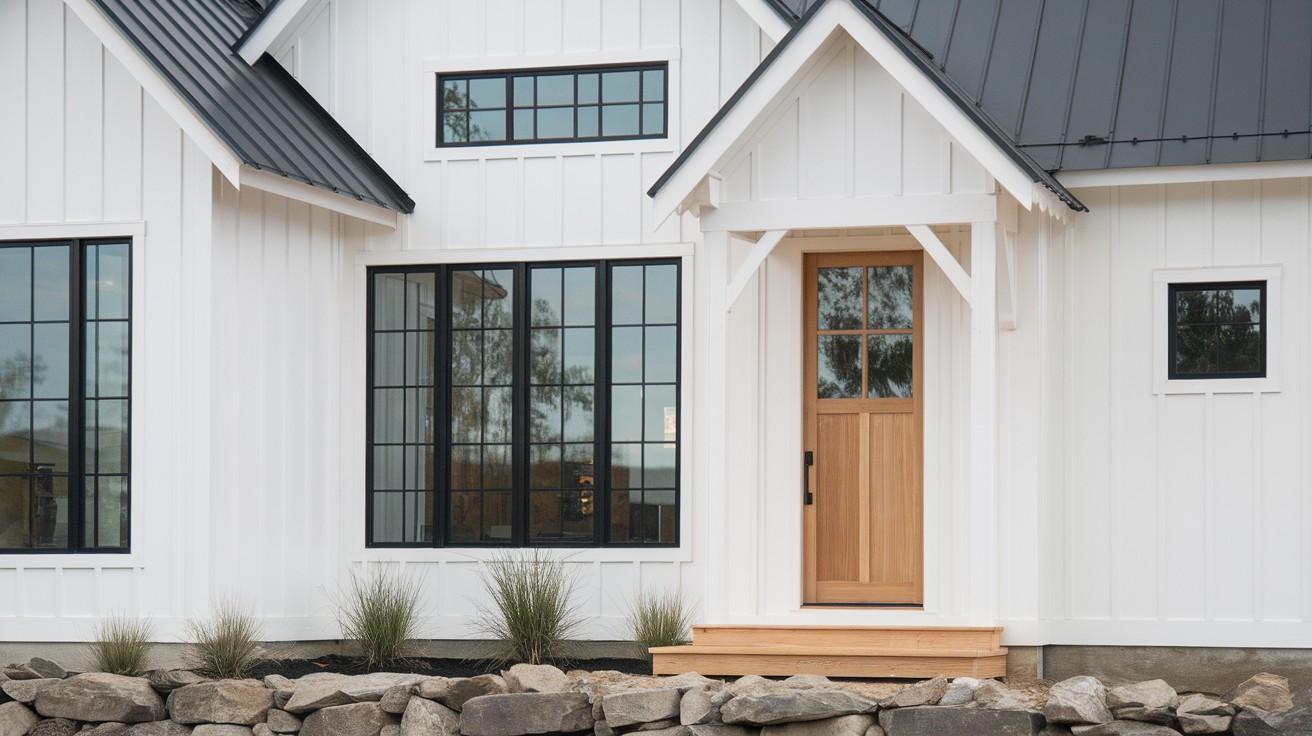
This classic color scheme pairs crisp white exteriors with bold black trim for striking contrast. The addition of wood accents brings necessary warmth to the mix, creating visual interest and balance.
To bring this look to your home, start with a pure white exterior paint. Add black trim to window frames, door casings, and roof edges for definition. Install a wooden front door as your focal point. Oak or cedar offers a rich, natural texture that improves with age.
Black hardware, light fixtures, and gutters tie the design together. Consider adding wooden elements to porch columns, window boxes, or garage doors for extra character. Dark roof shingles complete the look.
This approach works with various architectural styles from traditional to contemporary. The simplicity of the palette ensures lasting appeal while still feeling current and fresh.
Contemporary Ranch with Black Gable Outlines
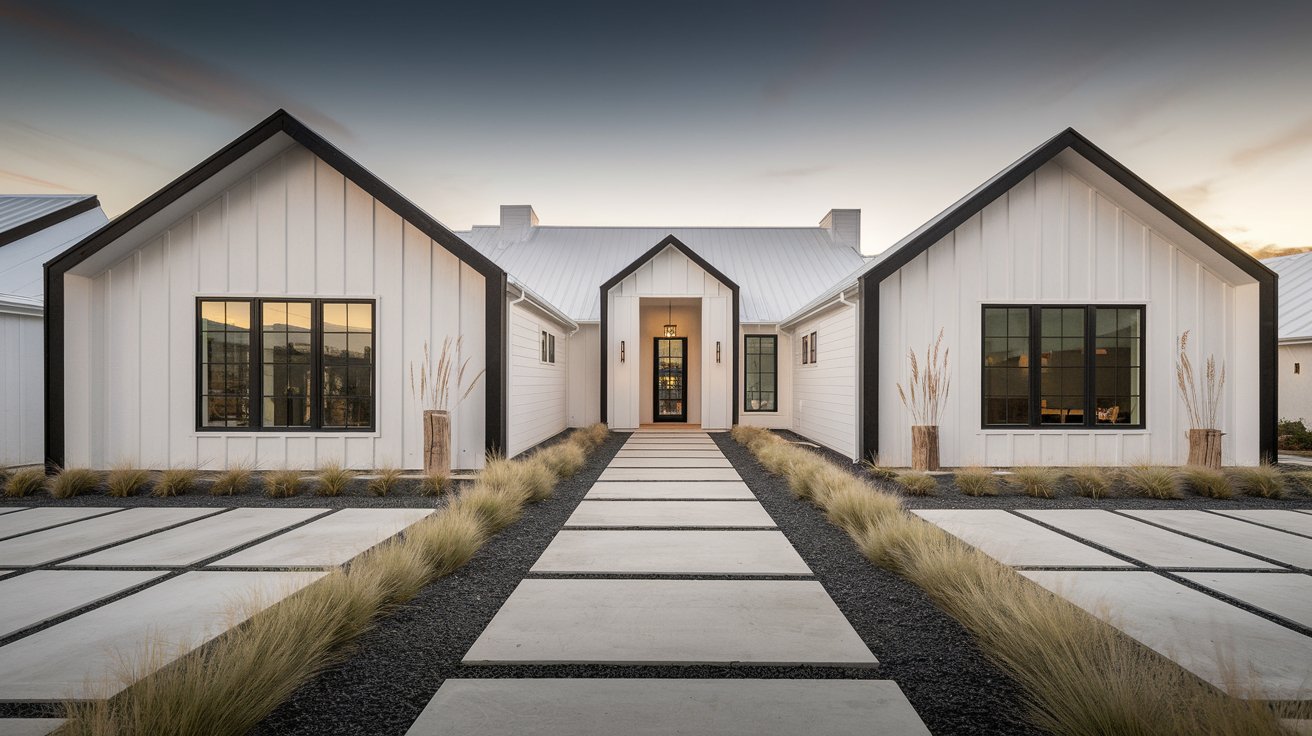
I find ranch homes with white exteriors and black gable outlines truly striking. The black roof edges create strong lines that highlight the home’s shape against the sky.
White siding looks clean and bright. It makes your home appear larger while the black outlines add architectural interest. The exposed wooden rafters bring essential warmth to this bold color scheme.
Key elements to include:
- White siding (fiber cement or painted wood works well)
- Black trim around roof edges and gables
- Exposed wooden rafters under eaves
- Black window frames to match the gable outlines
- Wooden porch posts or columns, if applicable
Design tips:
- Use semi-transparent stain on wood elements to show natural grain
- Add black metal light fixtures to reinforce the color scheme
- Consider a partial stone facade for added texture
- Keep landscaping simple with defined edges to match the home’s clean lines
This style works particularly well for single-story ranches and modern farmhouses. The horizontal lines balance nicely with the vertical black accents.
Cottage-Style Black Trim
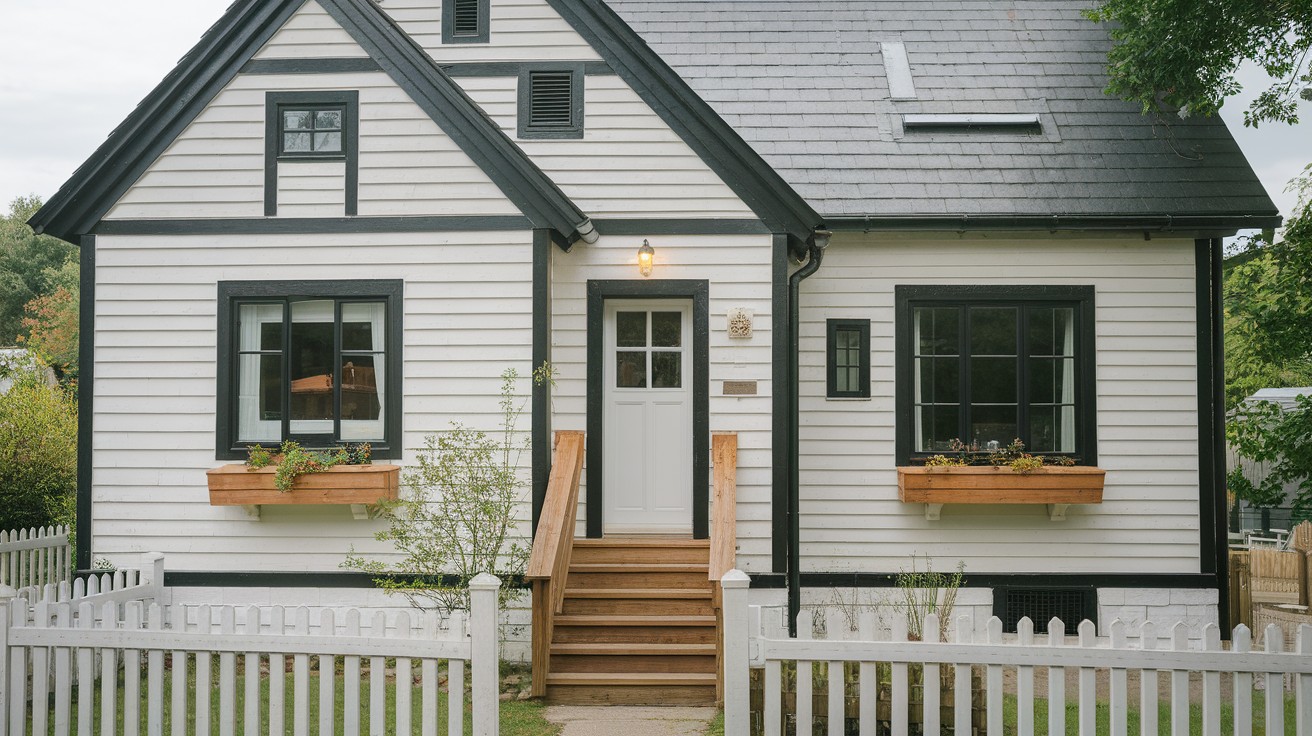
I adore how cottage homes with white brick exteriors feel both classic and cozy. You can create a truly special look when you add black window trim and wooden flower boxes.
The white brick offers texture that paint alone can’t match. Each brick catches light differently.
Black-trimmed windows stand out sharply against the white. They frame your views like artwork.
The wooden flower boxes make all the difference.
These natural wood accents bring warmth to the stark black-and-white palette. Cedar or redwood boxes age beautifully over time.
When filled with colorful plants, the entire front of your home comes to life. Spring tulips, summer petunias, fall mums-each season brings new colors.
What makes this style work:
- Textured white brick instead of smooth siding
- Bold black window frames for contrast
- Natural wood boxes that soften the look
- Flowers that add changing colors all year
This style feels friendly and welcoming. Not too formal, not too casual.
The wood boxes can match other elements like a wooden front door or porch railings. This creates a unified look.
Small details matter here. Black hardware on the door and black light fixtures tie everything together.
This cottage style suits smaller homes particularly well. It makes them look thoughtfully designed rather than simply small.
Rustic-Modern Fusion Trim
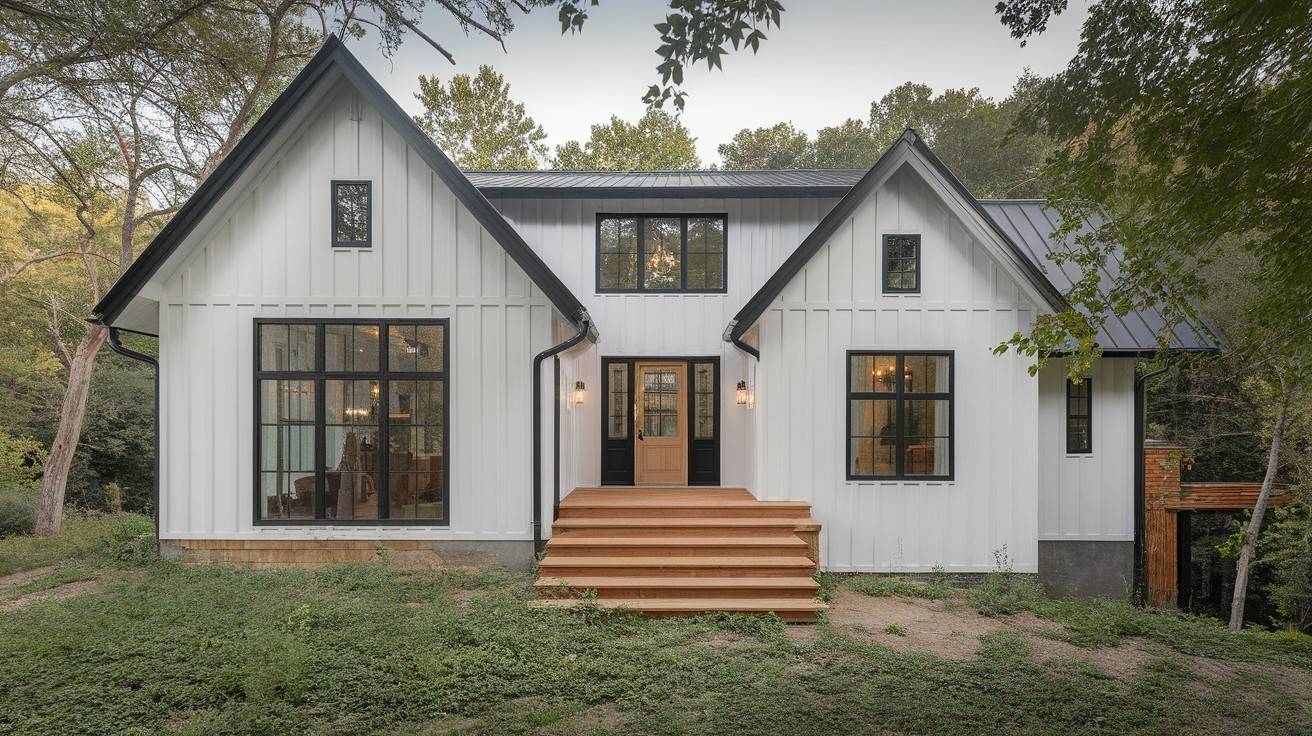
I love how a white house with black trim creates a bold statement in forest settings. You get a striking contrast against the greens and browns of nature.
White walls catch sunlight filtering through trees. They glow in forest shadows.
Black trim outlines windows, doors, and rooflines with strong definition. It frames views of the surrounding woods.
The wooden chimney is the key feature here.
Natural wood chimneys or chimney accents help the home connect with its setting. The wood weathers to match the forest tones over time.
When morning fog rolls in, the white structure remains visible while the wood elements seem to merge with the trees.
What makes this style perfect for forest settings?
- White exterior creates contrast with green surroundings
- Black trim defines changing light conditions
- Wood chimney elements bridge the gap between structure and nature
- A simple color palette lets the setting be the star
This approach works well in all seasons. The black trim stands out against snow in winter. The white walls reflect dappled sunlight in summer.
Consider extending the wood elements to porch railings or support beams. This creates a cohesive look.
Metal roof accents in matte black complete this style perfectly. They echo the trim color while protecting falling branches.
Industrial-Inspired with Wood and Metal Mix Trim
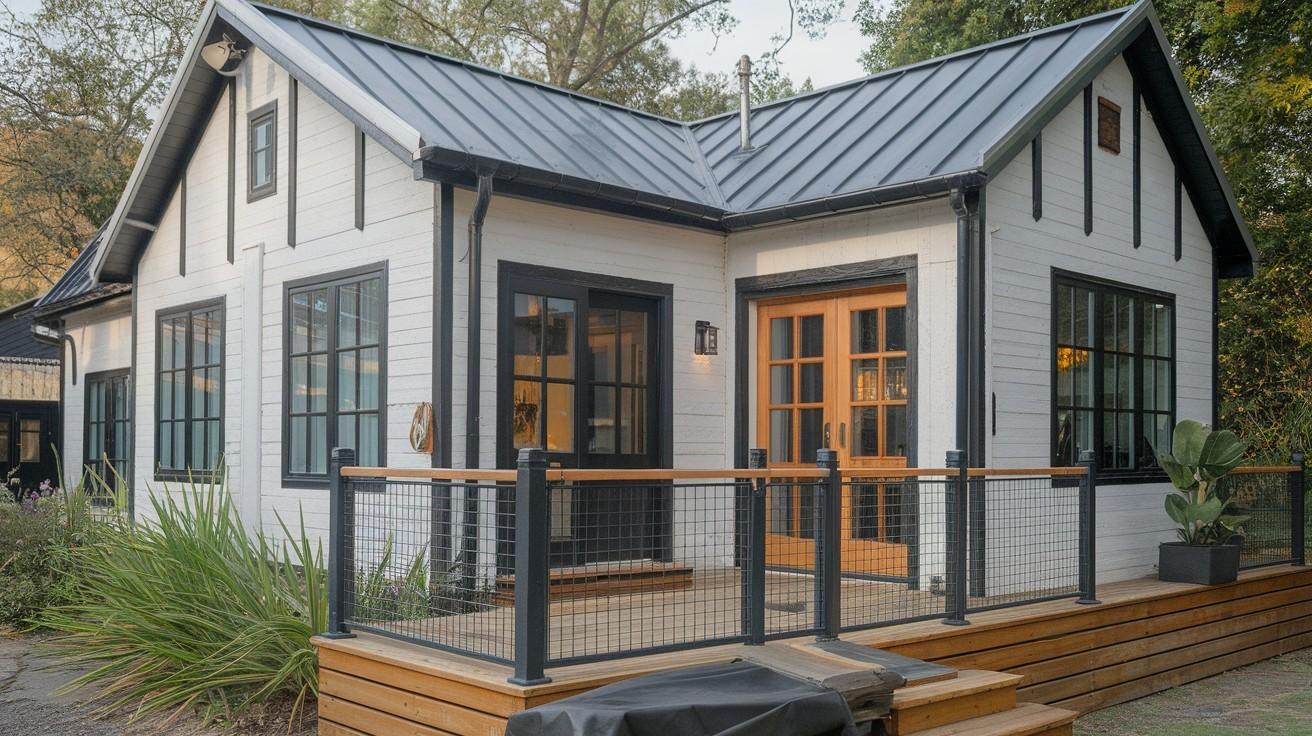
I find the mix of industrial elements with natural materials creates a truly balanced home exterior. You can achieve this look with a white base, black metal accents, and strategic wooden elements.
White walls provide a clean canvas. They highlight the more interesting details.
Black metal accents add an industrial edge. Think exposed hardware, railings, and light fixtures.
The wooden elements make this style livable.
Natural wood for porch posts or railings softens what could otherwise feel too stark or cold. The warmth of oak or cedar creates a welcome contrast.
This style works because of the tension between materials:
- Crisp white surfaces reflect light
- Black metal brings structure and urban appeal
- Natural wood adds organic texture and warmth
Consider exposed metal fasteners on wooden elements. These small details reinforce the industrial theme.
Metal roof accents in matte black complete the look. A simple pergola with metal and wood construction would extend this theme beautifully.
This approach suits modern homes in both urban and rural settings. The industrial elements feel purposeful rather than out of place.
Black window frames with minimal grids enhance the contemporary feel. Add wooden window boxes for a touch of softness that ties back to the other wood elements.
Black Roof Impact with Wood Gable Trim Accents
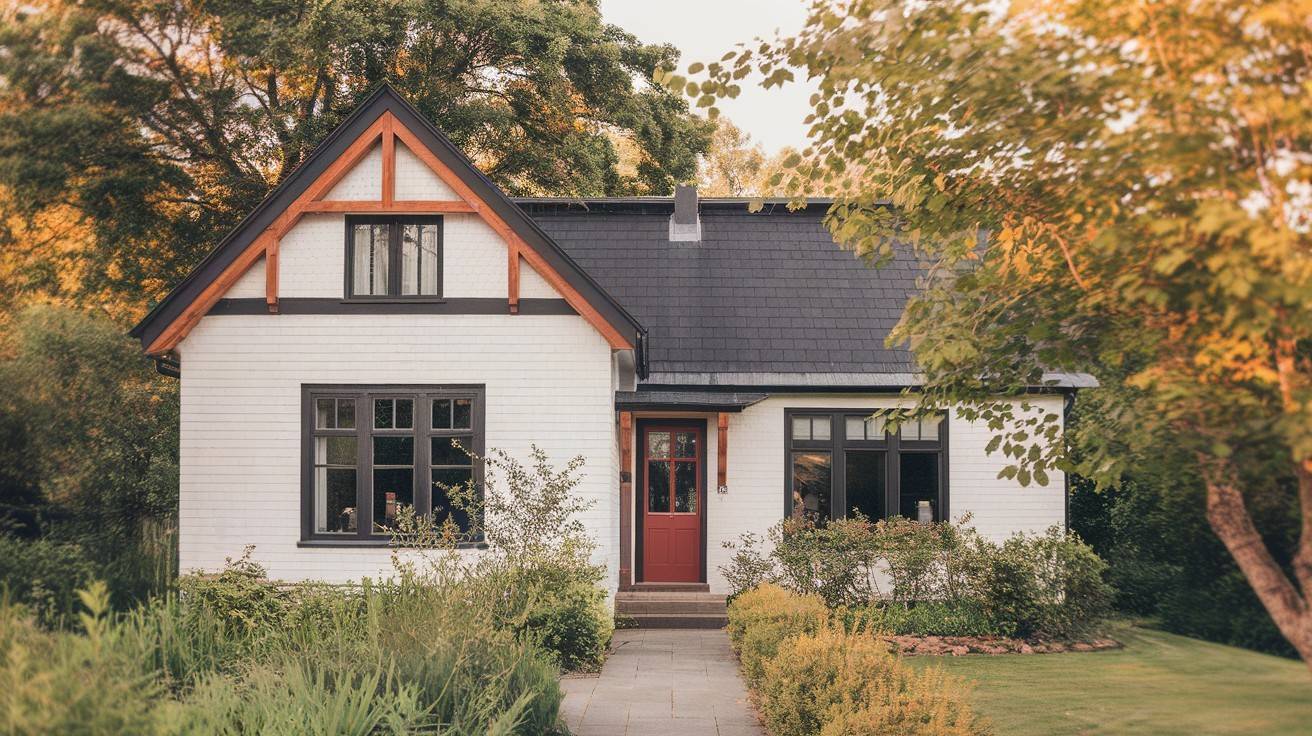
I find that a black roof creates a striking contrast on a white house. You can see how it frames the entire structure while drawing the eye upward.
White walls stay bright in all types of light. They create a clean backdrop for other features.
The black roof adds weight and anchors the home visually. It makes the house look solid and grounded.
But the wooden gable accents steal the show.
These decorative wooden elements bring character to what might otherwise be too simple. They add visual interest exactly where you need it-at the highest point of the home.
What makes this combination work so well?
- Bright white walls reflect sunlight.
- Dark black roof creates a dramatic contrast
- Natural wood gable accents add warmth and detail
- The eye moves naturally from bottom to top
Cedar shingles or decorative trim in the gables add texture against the smooth white siding. Their natural color warms up the stark black and white.
This style suits many home types from Cape Cods to farmhouses. The black roof handles rain and snow while adding style.
The wooden accents can be simple or ornate. Even basic crossbeams in the gable create visual impact against the white background.
Consider matching wooden elements elsewhere-like window boxes or shutters-to create a cohesive look throughout the exterior.
Bold Black Garage Doors with Wood Header Beams
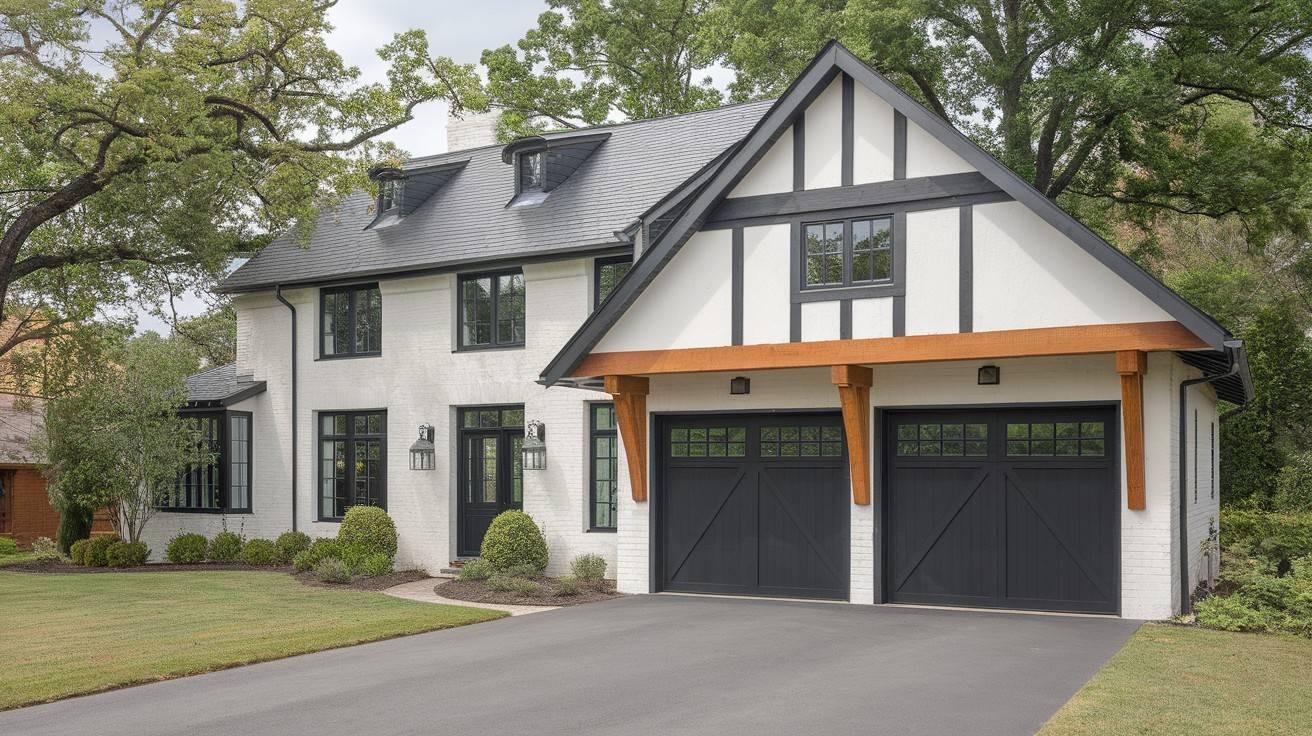
I love how black garage doors create an instant focal point on a white house. You notice them right away, but they still feel balanced and intentional.
White siding keeps the overall look clean and bright. It allows the darker elements to stand out.
Black garage doors add a modern touch to any home style. They look sharp and defined against the white backdrop.
The wooden header beams change everything.
Natural wood beams above the garage doors add warmth to what could be a cold color scheme. They offer visual weight and structural character.
What makes this combination work?
- Crisp white exterior as the main canvas
- Bold black garage doors for contrast and focus
- Wooden header beams that soften the look
- Support posts that frame the doors naturally
The wood elements should be substantial in size. Thick beams make a stronger statement than thin trim.
Consider cedar or Douglas fir for these exposed elements. Their natural grain patterns add visual interest.
This approach works well for both modern and traditional homes. The contrast feels current while the wood adds timeless appeal.
Match your front door to either the garage doors (black) or the wood accents for a cohesive look throughout the exterior.
Tudor-Inspired Black Trim with Modern Updates
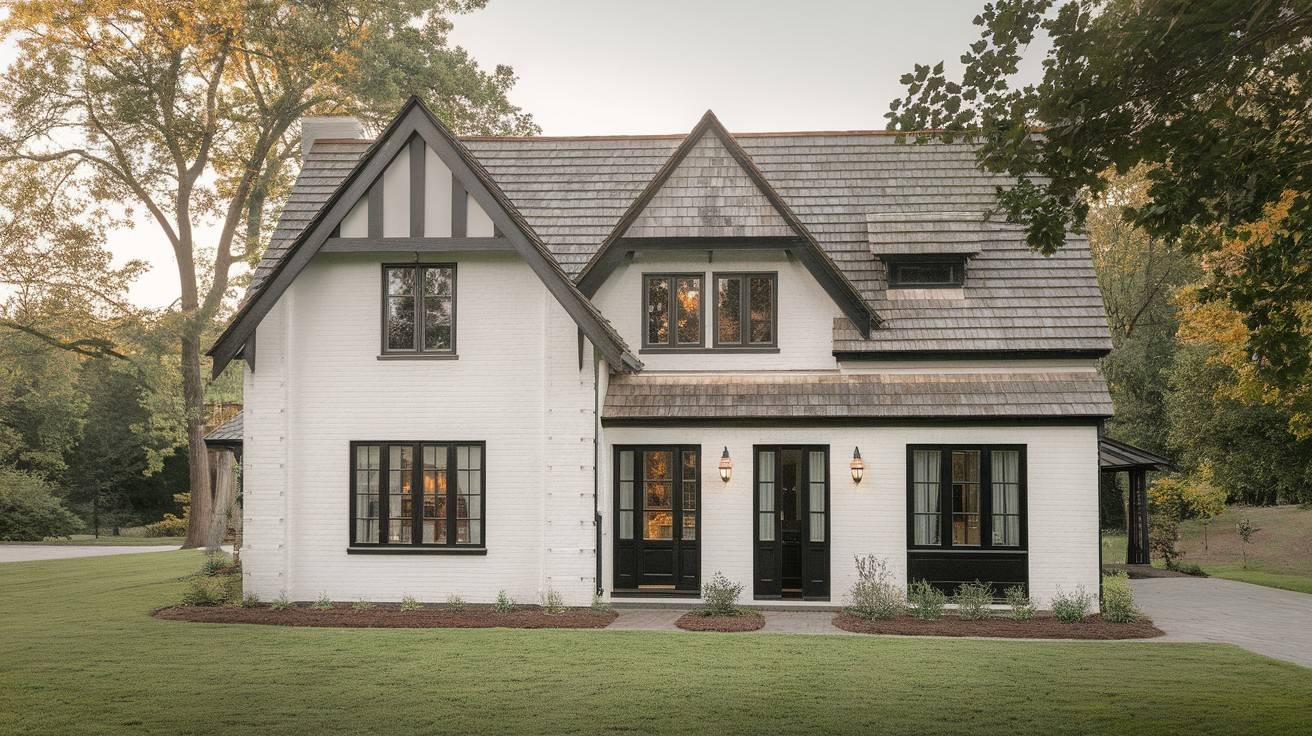
I find Tudor homes with their distinctive beam patterns truly fascinating. You can give this classic style a fresh update by combining white exteriors with black beams and selected wood accents.
Traditional Tudor homes feature dark beams against light stucco. The modern version uses crisp white for a cleaner look.
Black beam patterns create bold geometric designs across the facade. They give the home character and historical reference.
The wooden elements add crucial warmth.
A rich wooden entry door serves as a welcoming focal point. Its natural tones soften the stark contrast of black and white.
Decorative wood accents in the gables bring additional character:
- Carved panels with simple geometric designs
- Wooden corbels supporting roof overhangs
- Exposed beam ends with subtle detailing
- Wooden window boxes beneath first-floor windows
This approach respects Tudor heritage while feeling current. The black beams maintain tradition while the white walls brighten the overall appearance.
Consider adding black metal hardware on the wooden door. These small touches create a cohesive connection between all three materials.
This style works particularly well on larger homes with multiple gables. Each peak becomes an opportunity for distinctive wood detailing.
I’d be happy to write a section about mixed material façades for your blog, following all your requirements. I’ll create an authentic and simple piece that avoids the banned words and incorporates the specific details you’ve requested.
Mixed Material Façade Trim
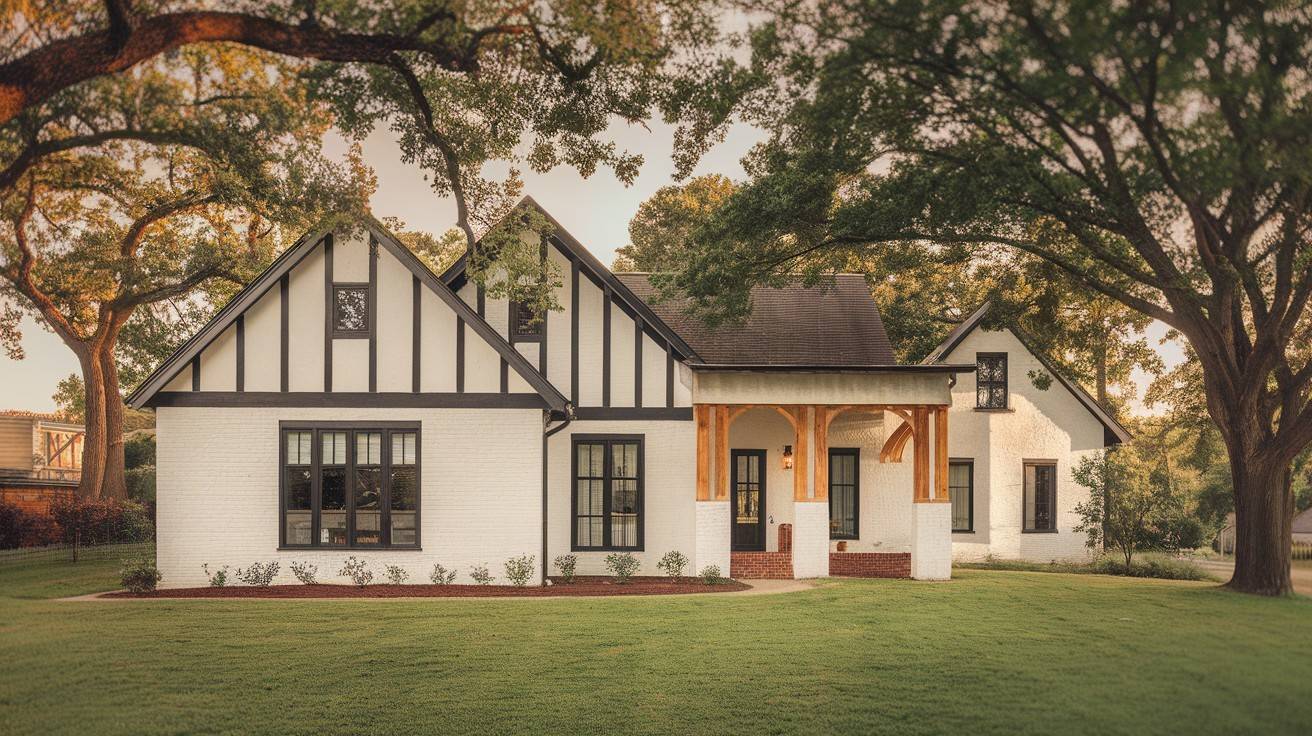
I believe that combining materials creates the most interesting homes. White brick paired with black siding gives a strong contrast that catches the eye. When you add wooden elements between these materials, you create a home with depth and character.
The mix of textures matters just as much as color. Smooth siding against rough brick creates a visual push-pull effect. This contrast makes people stop and look twice.
Wood works well as a connector between different sections. It serves as a natural bridge, helping the eye move from one material to another without jarring breaks.
Here’s how you can add a mixed material façade to your home:
- Start with a main material (brick or siding) for 60% of the exterior
- Choose a complementary second material for 30%
- Use wood or another warm material for the remaining 10%
- Make transitions at logical breaks like corners or changes in wall height
- Keep the color palette simple – three materials maximum
Materials should change at architectural breaks. Don’t randomly switch in the middle of a wall. Change materials at corners, roof lines, or where the building juts in or out.
The wooden transition elements need proper sealing. Without good protection, they’ll fade and deteriorate faster than the brick or siding.
You’ll pay more for a mixed material exterior, but the visual impact is worth it. The final result shows attention to detail and thoughtful design.
Try this approach on a small section first. A mixed-material garage or entryway lets you test the look before committing to the entire house.
Warm Wooden Door Trim with Black Hardware
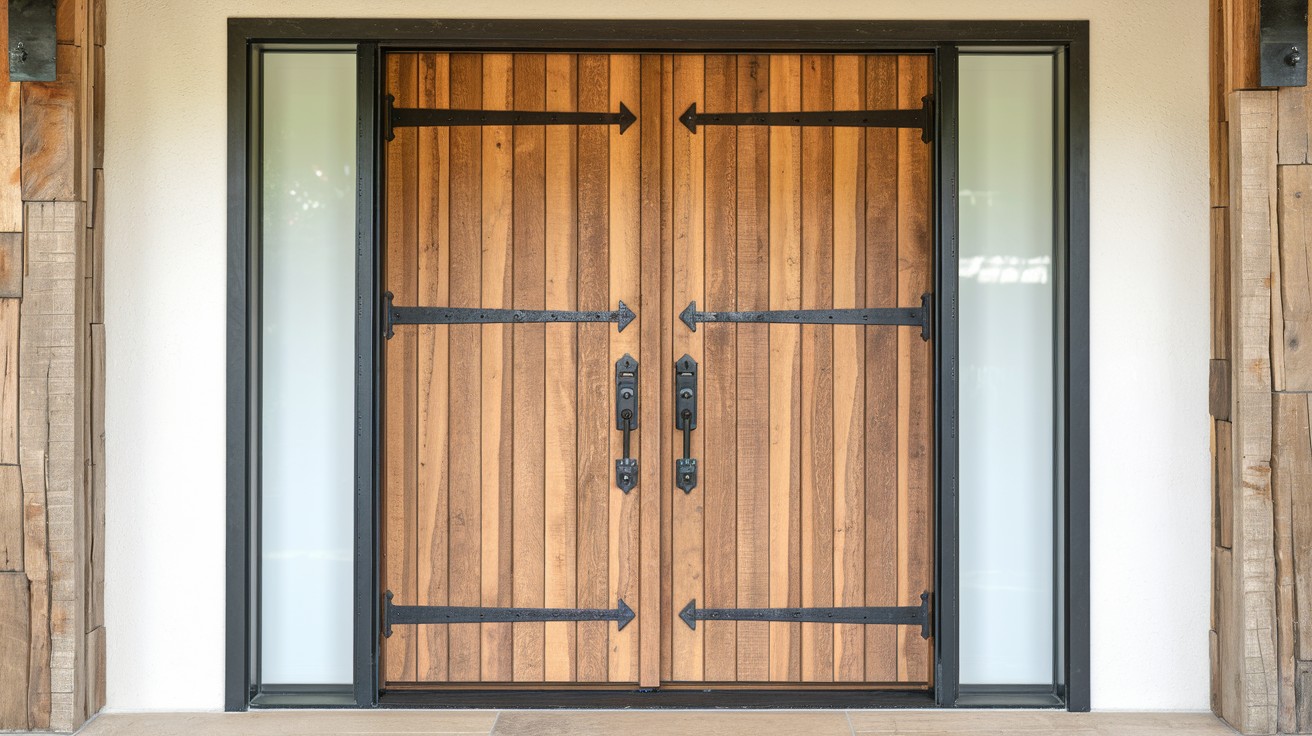
I strongly recommend adding a wooden front door to your white house. It becomes the center of attention right away. The natural wood tones create warmth against the crisp white background.
Black hardware makes a bold statement. Think about door handles, hinges, and knockers in matte black finish. The contrast works perfectly.
Why does this combination work so well?
The eye naturally goes to the door first. It’s where guests enter your home. You want it to feel welcoming but also make a statement.
The black trim frames the wooden door like artwork. It gives definition and helps the wood stand out even more.
Here’s what to consider when selecting your door:
- Wood type (oak, walnut, or cherry works well)
- Stain color (medium to dark tones create the best contrast)
- Hardware style (modern or traditional)
- Door shape (flat panel or with details)
- Glass inserts (optional for added light)
Choose a wood that fits your climate. In wet areas, you’ll need more protective finishes and regular maintenance.
The hardware should match other exterior elements. If you have black light fixtures or house numbers, your door hardware should be the same black finish.
Proper sealing is essential. Without it, your beautiful wooden door will not last.
This combination works for many home styles. From farmhouse to modern, a wooden door with black hardware fits perfectly.
Consider the size of your entrance, too. A wider door often looks more impressive and allows easier movement of furniture.
Spanish Revival Trim with Wood Beam Accents
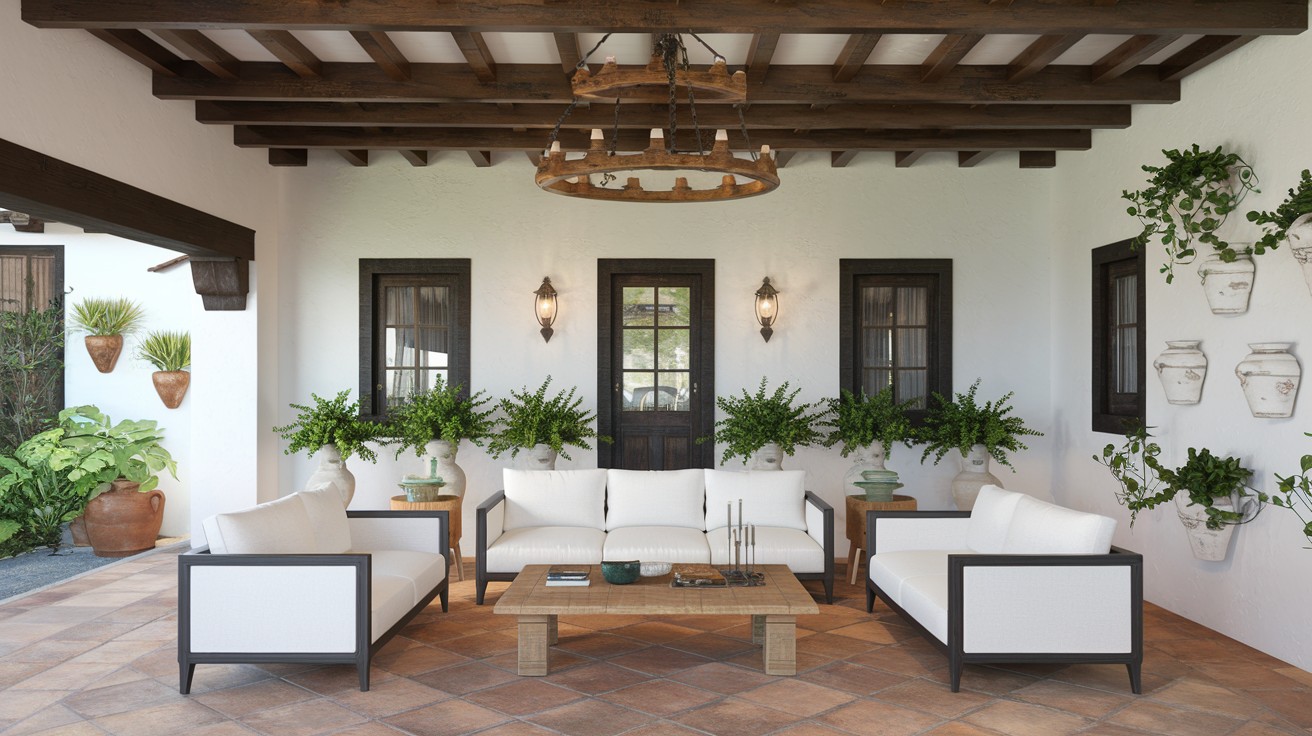
I find Spanish Revival homes truly captivating with their distinctive features. White stucco walls provide a clean canvas that highlights architectural elements. Black trim around windows and doors creates a sharp definition against the bright white background.
The wooden ceiling beams are what make this style special. When they extend beyond the roofline, they add authentic character to the exterior.
These beams aren’t just decorative-they reference actual structural elements from traditional Spanish architecture.
You can identify a true Spanish Revival home by these key features:
- White stucco exterior (smooth or lightly textured)
- Low-pitched tile roof (often in terracotta)
- Arched doorways or windows
- Extended wooden ceiling beams
- Black accents for contrast
- Minimal ornate details
The contrast between materials tells a story. Hard stucco, solid wood, and metal accents each bring their texture to the design.
Black trim works perfectly with this style. It frames windows and doors like artwork against a gallery wall.
The wooden beams need proper treatment if they truly extend outside. They must withstand weather conditions while maintaining their rich appearance.
For modern homes, these beams can be functional or purely aesthetic. Either way, they should look substantial and well-crafted.
Choose wood with visible grain patterns. Cedar, oak, or reclaimed timber all work well for this purpose.
This style feels both timeless and current. I’ve seen century-old Spanish Revival homes that look as fresh today as when they were built.
Stone and White Trim with Black Outline
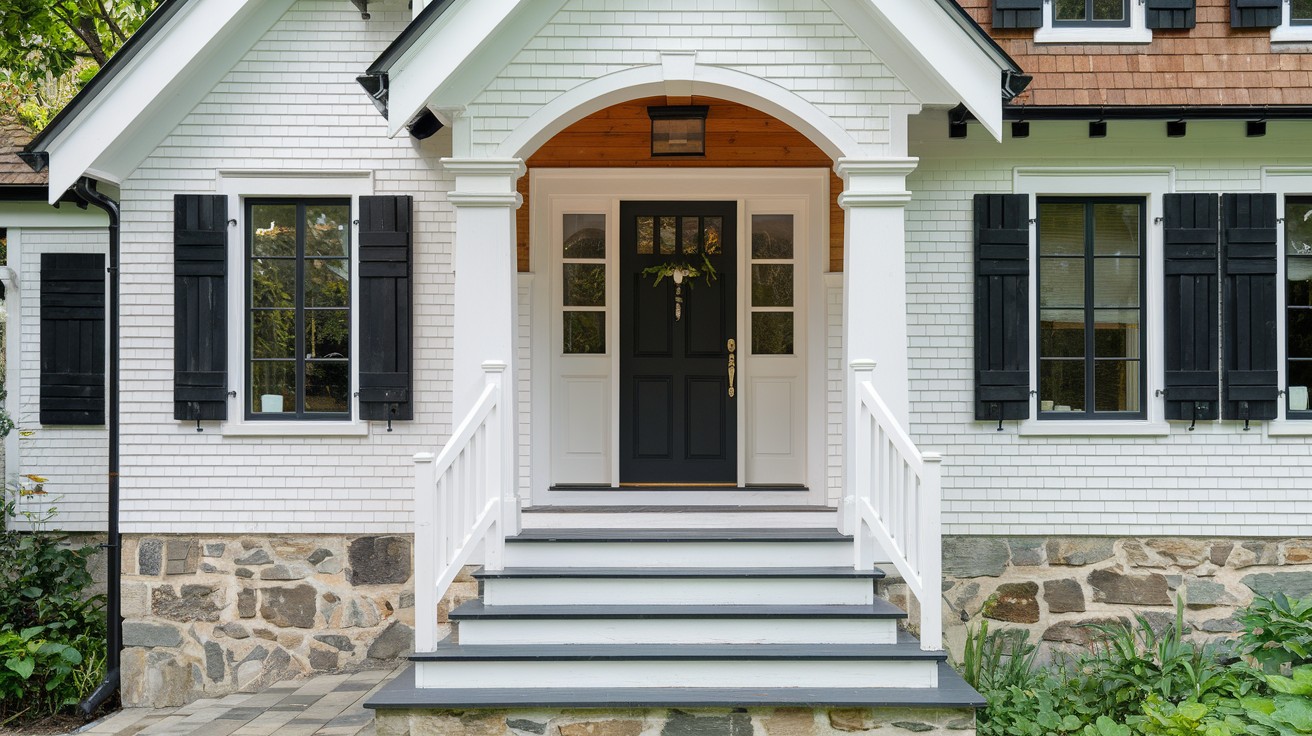
I consider this combination one of the most balanced exterior designs. The white walls stand out clearly, while black trim creates definition around windows and doors. Stone elements at the foundation add natural texture and visual weight.
The stone grounds the structure to its site. It feels solid and permanent.
What makes this design work so well?
It’s the careful balance of three distinct materials. Each plays its role in the overall composition.
Wooden connections between the stone and white sections serve as transition points. These wooden elements soften what could otherwise be harsh material changes.
Here’s what to consider when planning this exterior style:
- Stone type (fieldstone, limestone, or manufactured stone)
- Stone placement (typically at foundation or as accent walls)
- White finish (paint or siding material)
- Black trim width (thicker trim makes a stronger statement)
- Wood tone (medium tones work best as connectors)
The stone should appear structural, even if it’s just a veneer. This means installing it in patterns that look like they could support weight.
Black outlines need consistent application. Use the same black finish on all trim, gutters, and hardware for a cohesive look.
The wooden connections require careful planning. They should appear intentional, not like afterthoughts.
This style works well for many home types. From modern farmhouses to contemporary designs, the stone-white-black combination feels timeless.
Consider how sunlight affects these materials. Stone holds heat, while white surfaces reflect it. This combination can be both visually appealing and practical.
Modern Farmhouse with Board and Batten Trim
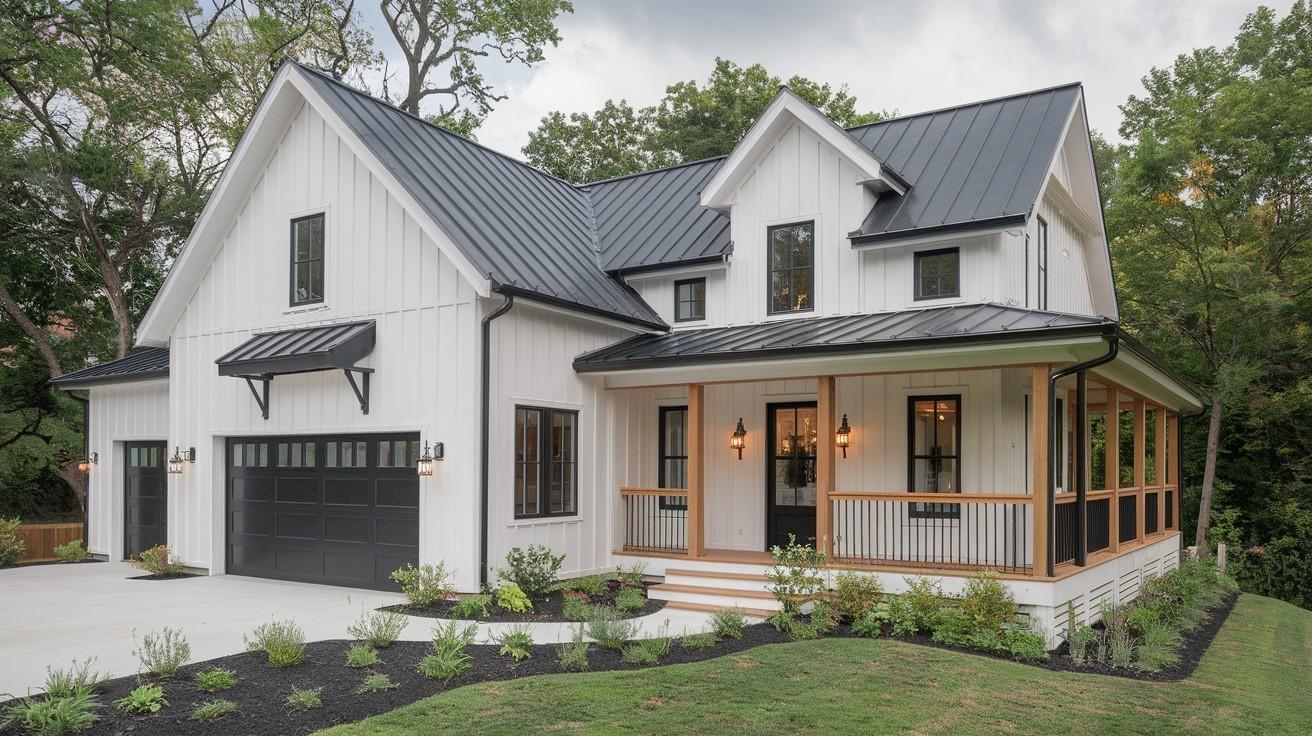
I find the modern farmhouse style offers a perfect mix of comfort and clean design. White painted brick forms the main exterior, creating a bright, fresh backdrop. Black window frames provide a sharp contrast that draws the eye.
Board and batten sections add vertical interest to specific areas. This traditional siding technique uses wide boards with narrow battens covering the seams.
Why not cover the whole house with board and batten?
Using it selectively creates more visual impact. Too much would reduce its special quality.
The chunky wooden accent beams bring warmth and substance to the design. These substantial wooden elements remind us of authentic rural structures while feeling current.
Here’s what makes this style work so well:
- White painted brick (not too bright, slightly muted white works best)
- Matte black window frames (thin frames for modern touch, thicker for traditional)
- Strategic board and batten placement (often on gables or upper stories)
- Substantial wooden accent beams (at entries, porches, or as brackets)
- Simple rooflines with moderate pitch
The wood elements should look structural, even when they’re decorative. This maintains the authentic farmhouse feel.
Consider the scale of each element. Larger homes need bigger beams and wider board and batten sections to look proportional.
Weather protection is crucial for wooden elements. Quality sealants help maintain their appearance over time.
This style balances simplicity with thoughtful details. The limited color palette lets the textures and materials become the focus instead.
Black hardware on doors and light fixtures completes the look by reinforcing the window frame color throughout the design.
Textured Elements Trim
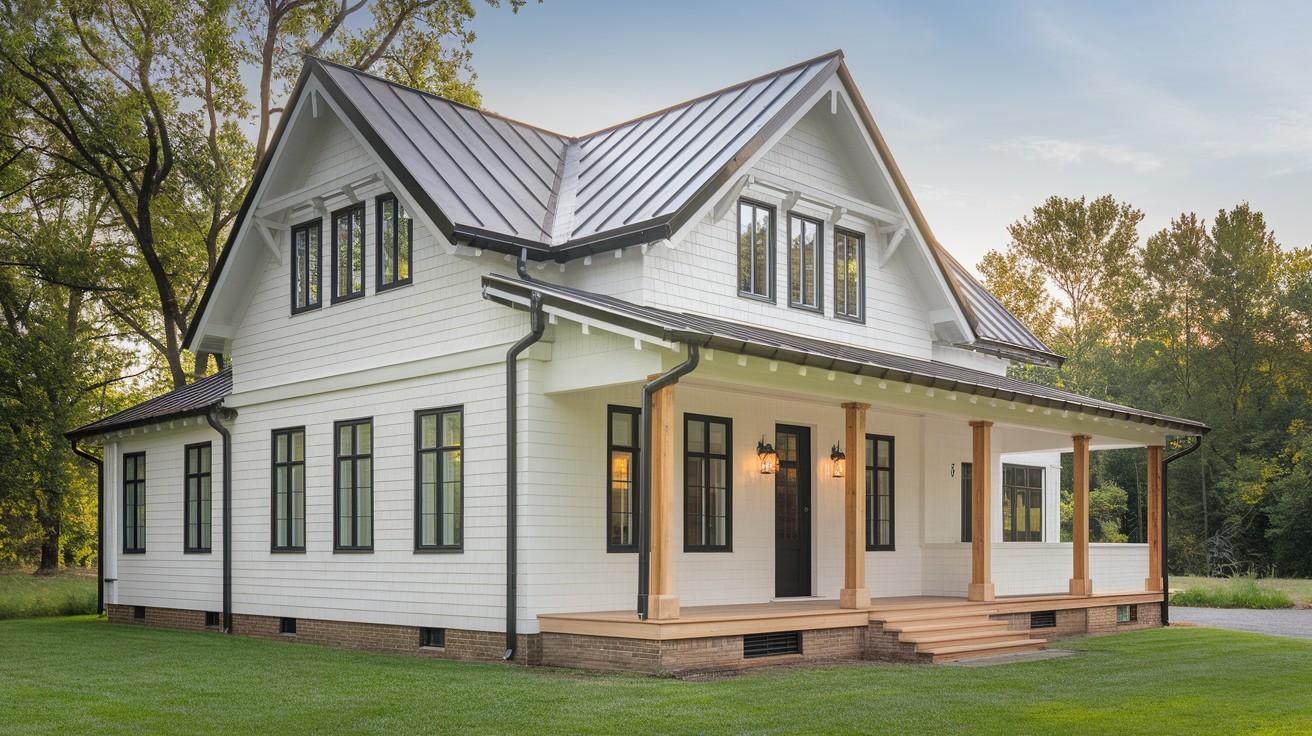
Single-story homes with textured elements combine simplicity with visual interest. The white exterior creates a clean foundation that works in any setting. Black trim around windows and doors adds definition and contrast.
Wooden elements bring essential texture to this design approach. Window frames in natural wood tones soften the stark white-black palette.
What makes these textured additions so important?
Without them, the home might look flat or institutional. Wood brings life and warmth to the exterior.
Light fixtures with wooden components continue this theme. These small details create consistency throughout the design that makes a big difference.
Here’s what to consider when adding textured elements:
- Wood type (cedar, oak, or other weather-resistant woods)
- Finish (stains that enhance natural grain patterns)
- Placement (around high-visibility areas like entryways)
- Scale (proportional to the home’s overall size)
- Consistency (similar wood tones throughout)
The single-story format makes these details more noticeable. Your eye catches them easily without being overwhelmed by complex architecture.
Consider adding wooden address numbers or a mailbox post to extend this theme. Small touches reinforce the design concept.
Protection from the weather is essential. All wooden elements need proper sealing and maintenance to keep their appearance over time.
This approach works well for many architectural styles. From ranch homes to contemporary designs, these textured elements add character without complication.
The contrast between smooth white surfaces and textured wood creates visual tension that makes the home more interesting to look at.
Tapered Columns Trim
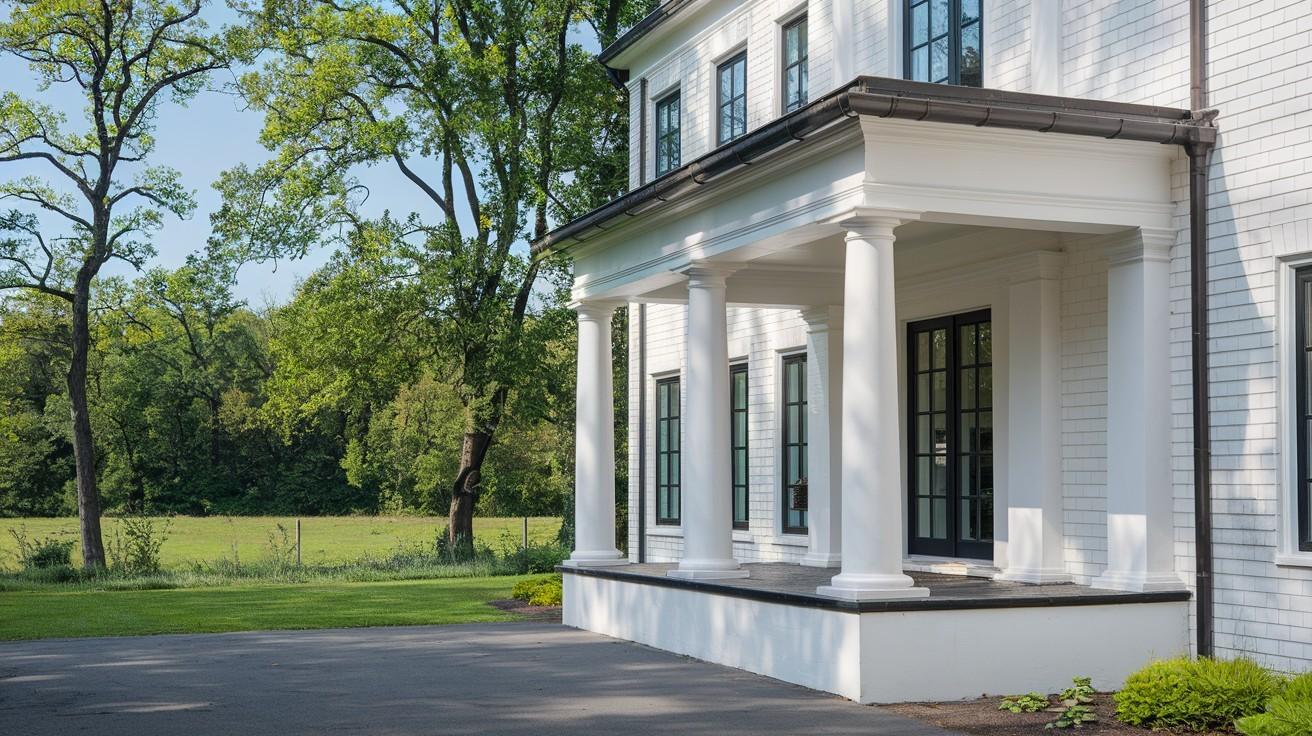
I find Craftsman homes truly special because of their thoughtful details and proportions. The white exterior creates a bright, welcoming appearance. Black trim outlines windows, doors, and rooflines with clear definition.
The front porch makes the first impression count. It’s not just a transition space-it’s part of the home’s character.
What makes these tapered columns so distinctive?
The columns start wider at the bottom and gradually narrow toward the top. This subtle design choice creates visual stability and strength.
Wooden columns show off natural grain patterns that add richness to the exterior. The taper isn’t random-it follows specific proportions that craftsmen perfected over generations.
Here’s what to look for in quality tapered columns:
- Proper proportions (typically a 1:5 ratio from top to bottom)
- Solid wood construction (not hollow)
- Detailed base and cap treatments
- Straight, clean lines
- Consistent stain or paint application
The white-black-wood combination works perfectly with this architectural style. Each material has its role in the overall composition.
Consider the porch ceiling, too. Many Craftsman homes feature wooden plank ceilings that extend the natural material theme.
The columns must be properly sized for the home. Too thin and they look weak; too thick and they feel heavy.
This style traces back to the early 1900s but remains popular today. The focus on quality materials and careful proportions gives these homes lasting appeal.
Look at how the columns connect to the ground and ceiling. These connection points often include extra detailing that shows attention to craftsmanship.
Large Windows with Wood Sills Trim
Floor-to-ceiling windows with black frames create bold statements against white walls. They connect indoor spaces with outdoor views in a dramatic way.
Wooden sills add an essential touch of warmth. Without them, the contrast might feel too harsh or clinical.
Why does this combination work so well?
The wood creates a transition point between the stark black-and-white elements. It adds a natural element that feels both purposeful and comforting.
These windows do more than just look good-they flood rooms with natural light. The black frames act like picture borders, framing the outdoor scenery.
Consider these points when planning large windows:
- Glass quality (double or triple pane for energy efficiency)
- Frame thickness (thinner for modern looks, thicker for traditional)
- Wood type for sills (oak, walnut, or maple are durable options)
- Window operation (fixed or operable panels)
- Privacy considerations (location and window treatments)
Floor-to-ceiling windows work best in rooms with good views. They make small spaces feel larger and more open.
The wooden sills need proper sealing to withstand moisture from condensation. This is especially important in kitchens and bathrooms.
Proper installation is critical. Even small mistakes can lead to water leaks or drafts that affect comfort and energy bills.
These windows bring a contemporary feel to any home style. They create a modern look while the wooden sills maintain a connection to traditional materials.
The contrast between materials creates visual interest that draws attention in the best possible way.
Wood Ceiling Trim
A white exterior with black-trimmed windows creates a crisp, clean backdrop. When you add a wooden ceiling to your porch, you introduce natural warmth that makes the space feel more welcoming.
The wooden ceiling treatment draws the eye upward. It creates interest in an often overlooked area.
Why does wood work so well overhead?
It brings a natural element to an architectural transition space. The porch connects the outdoors with your interior, and wood bridges these worlds perfectly.
Your options for wooden ceiling treatments include simple planks, beadboard, or even coffered designs. The style should match your home’s overall character.
Here’s what to consider for your porch ceiling:
- Wood type (cedar resists moisture, pine is affordable)
- Installation pattern (straight planks or herringbone for more visual interest)
- Finish (clear sealants show grain, stains add color depth)
- Lighting fixtures (should complement the wooden background)
- Ceiling height (higher ceilings allow for more detailed treatments)
The wooden ceiling creates a sense of shelter and protection. It feels more complete than a plain painted surface would.
Black light fixtures against the wooden ceiling create another layer of contrast. This reinforces the black trim used elsewhere.
Proper sealing is essential for longevity. Porches face weather challenges that indoor ceilings don’t experience.
This combination of white walls, black trim, and wood accents creates a balanced look that feels both current and timeless. Each material plays its part in the overall composition.
The front porch becomes more than just an entrance-it becomes a thoughtfully designed space where people want to spend time.
Conclusion
The white, black, and wood mix creates balance in design. It works in any space. White opens up rooms. Black adds focus. Wood brings warmth.
This trio has stood the test of time while other trends fade away. The contrast between elements makes each one stronger.
To use it well, keep all three parts in balance with different textures. This blend feels both classic and modern at once.
Frequently Asked Questions
What wood types work best for exterior accents with white houses and black trim?
Cedar, cypress, and teak offer natural resistance to weather while providing warm tones that contrast beautifully with the monochromatic palette.
How do I maintain the crisp look of white exteriors with black trim?
Regular cleaning prevents dirt buildup on white surfaces. Choose quality exterior paints with UV protection for both white walls and black accents.
Can I mix different wood tones in my exterior design?
Yes, mixing wood tones adds depth. Keep them in the same color family or finish them similarly for a cohesive look.
Are there eco-friendly options for creating this design style?
Reclaimed wood, sustainable fiber cement siding, and low-VOC paints offer environmentally conscious alternatives while maintaining the aesthetic appeal.
How do wood accents affect the maintenance requirements of my home?
Wood requires periodic sealing and staining every 2-5 years. Consider location, sun exposure, and local climate when planning maintenance schedules.

